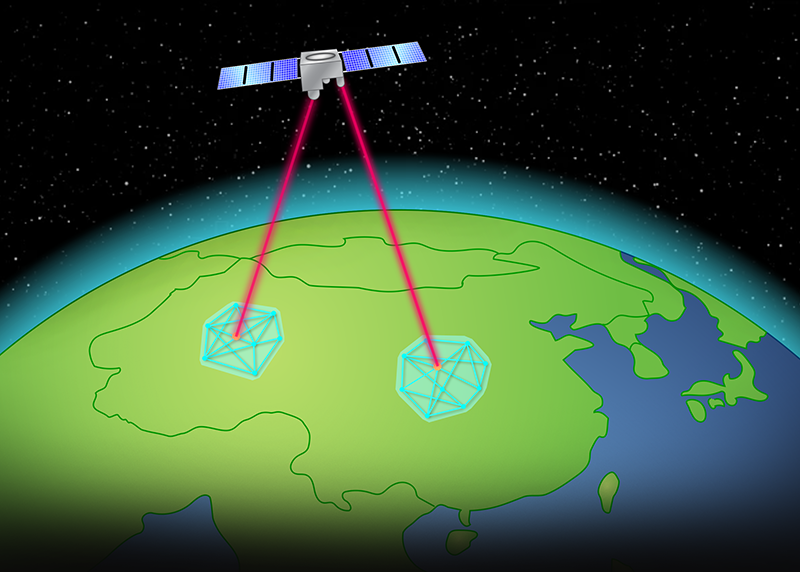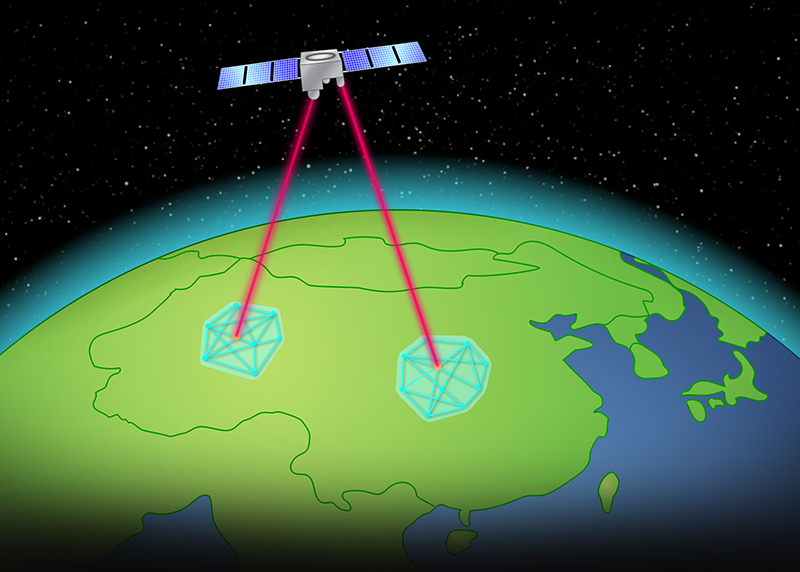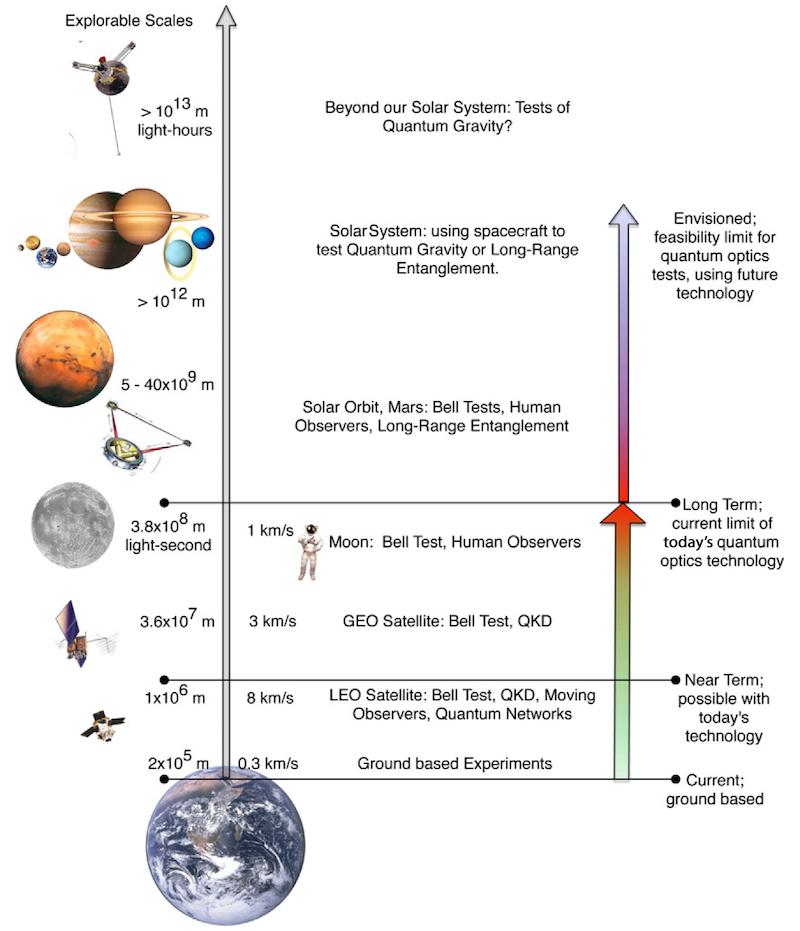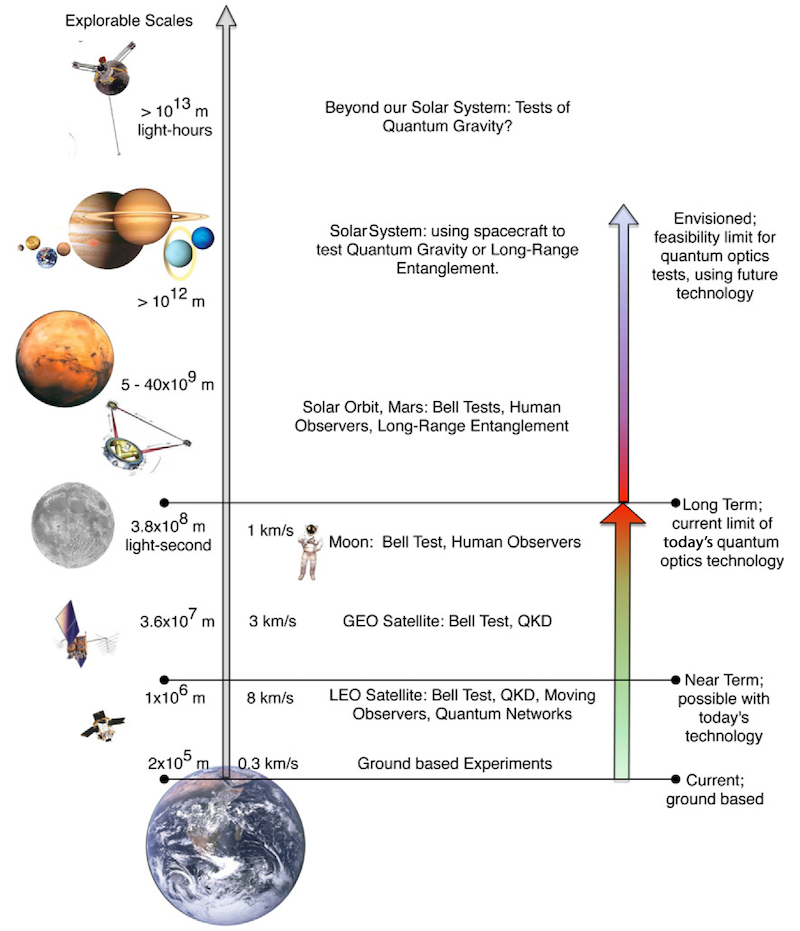Paving the Way for Satellite Quantum Communications
Few things have captured the scientific imagination quite like the vastness of space and the promise of quantum technology. Micius—the Chinese Academy of Science’s quantum communications satellite launched in 2016—has connected these two inspiring domains, producing a string of exciting first demonstrations in quantum space communications. Reviewing the efforts leading up to the satellite launch and the major outcomes of the mission, Jian-Wei Pan and colleagues at the University of Science and Technology of China provide a perspective on what the future of quantum space communications may look like [1]. The success of this quantum-satellite mission proves the viability of several space-based quantum communications protocols, providing a solid foundation for future improvements that may lead to an Earth-spanning quantum communications network (Fig. 1).
Photons, the quanta of light, are wonderful carriers of quantum information because they are easy to manipulate and travel extremely fast. They can be created in a desired quantum state or as the output of some quantum sensor or quantum computer. Quantum entanglement between multiple photons—the nonclassical correlation between their quantum states—can be amazingly useful in quantum communications protocols such as quantum key distribution (QKD), a cryptography approach that can theoretically guarantee absolute information security. QKD schemes have been demonstrated on distances of a few hundreds of kilometers—sufficient to cover communications networks between cities. But increasing their range, eventually to the global scale, is a formidable challenge.
A key barrier to long-distance quantum communications is related to the losses—from absorption and scattering—incurred by light traveling along optical fibers or through the atmosphere. While in classical communications optical amplifiers can be used as repeaters that compensate for such losses, the amplification of individual photons corrupts their quantum information. Researchers are investigating various quantum repeater technologies that could overcome this limitation, but quantum repeaters will not soon be ready to support intercontinental quantum communications. The only viable, near-term approach is offered by the free-space optical channel, linking low-Earth-orbit satellites to Earth. The advantage of this approach is that the photons’ transmission path—except for the lower ∼10 km of the atmosphere—is virtually in a vacuum, with negligible absorption and scattering. A satellite link between two ground stations 1200 km apart (as in Micius’ 2017 demonstration [2]) is 15 orders of magnitude more efficient in term of losses than an optical fiber link.
Transmitting light from a satellite to Earth, however, has other challenges. For example, the satellite’s telescopes and those on the ground must continuously stay pointed at one another to optimize signal transmission. This pointing can be complicated by atmospheric conditions that randomly deflect and distort the light beams. In addition, the satellite and ground station need to synchronize their clocks to identify signal photons based on arrival times. Solutions to these and other issues were demonstrated by programs in China [3, 4] and incorporated in Micius’ design. Programs in other countries (such as NASA’s Lunar Laser Communication Demonstration) also demonstrated solutions to these issues.
Micius features several onboard capabilities for quantum communications. Its main instrument is a Sagnac interferometer, in which “pump” photons are split by a nonlinear crystal into pairs of photons. The interfering paths of the interferometer lead to the entanglement of the polarization states of the two photons in each pair. The device can emit over 5 million entangled photon pairs per second, which are sent to stations on the ground.
Micius was launched into a 500-km-altitude orbit and, in coordination with ground stations on different continents, carried out a series of remarkable demonstrations. The mission quickly achieved one of its key objectives—demonstrating long-distance entanglement distribution. In 2017, experiments showed that two photons from an entangled pair could be separated and distributed to two stations (Delingha and Lijiang, both in China) 1200 km apart while preserving their entanglement [2]. The result more than doubles the distance record previously achieved with optical fibers. Only 10 days after the launch, Micius demonstrated QKD between the satellite and a ground station near Beijing, using a protocol known as decoy-state BB84, which uses, instead of entangled photons, weak coherent pulses. In a 273-s connection window, the experiment shared about 300 kilobits of random key—an amount sufficient to exchange an industry-standard 256-bit key every day for 3 years [5]. Using that QKD system, Micius distributed 100 kilobytes of secure keys to ground stations in China and Austria, which were used to secure a 75-minute videoconference between Beijing and Vienna with 128-bit keys, refreshing such keys every second [6].
In the 2017 videoconference, the protocol security relied on the assumption that Micius was a trusted relay. Achieving entanglement-based QKD between two ground-based stations would not require this assumption and was the next goal for Micius. With various system improvements, the researchers were able to achieve such a goal, enabling QKD between two ground stations separated by over 1100 km, albeit with only 6 bits of final secure key per pass [7, 8]—enough for a technology demonstration, but not for any practical applications. Higher efficiency links and increased entangled-photon generation rates will be required for a viable satellite-to-double-ground-station system.
As Pan and his coworkers write, “Micius marks only the beginning.” Its results motivate researchers worldwide to take the next steps needed to truly enable a global quantum network. For instance, the Micius program operated at night to avoid background from the Sun. With better background filtering, daytime operation would greatly increase the possible satellite-to-ground link opportunities. Further work is needed to extend operations to the case in which different parts of a quantum teleportation experiment, such as a Bell-state-measurement setup and the entangled photon source, are located in reference frames that move with respect to each other (ground stations and satellites). When the Micius researchers demonstrated quantum teleportation [9], they located all parts of the experiments on the ground and sent the already-teleported photon to the satellite, where it was measured. The extension to moving frames will be vital for a functioning quantum repeater network. Still further out is the demonstration of quantum information transmission methods that are tolerant to loss and other operational errors. Finally, Micius is a low-orbit satellite, but high-orbit satellites will be required to provide wider coverage.
Ultimately, we envision that global quantum communications networks will involve a combination of quantum-satellite constellations—providing intercontinental connectivity—and fiber quantum networks—connecting metropolitan networks on the ground. But besides technological applications, satellites could also enable intriguing fundamental tests at the intersection of quantum physics and relativity. The speeds, distances, and variations in gravity accessible with space-based experiments will allow researchers to probe how gravity affects quantum phenomena, which could pave the way toward the development of a quantum gravity theory [10].
Micius has shown that the future is bright for both fundamental and practical applications of quantum communications via satellite (Fig. 2), and we have only begun to scratch the surface of what is possible.
References
- C. Y. Lu et al., “Micius quantum experiments in space,” Rev. Mod. Phys. 94, 035001 (2022).
- J. Yin et al., “Satellite-based entanglement distribution over 1200 kilometers,” Science 356, 1140 (2017).
- J. Yin et al., “Quantum teleportation and entanglement distribution over 100-kilometre free-space channels,” Nature 488, 185 (2012).
- J. Y. Wang et al., “Direct and full-scale experimental verifications towards ground–satellite quantum key distribution,” Nat. Photonics 7, 387 (2013).
- S. K. Liao et al., “Satellite-to-ground quantum key distribution,” Nature 549, 43 (2017).
- S. K. Liao et al., “Satellite-relayed intercontinental quantum network,” Phys. Rev. Lett. 120, 030501 (2018).
- J. Yin et al., “Entanglement-based secure quantum cryptography over 1,120 kilometres,” Nature 582, 501 (2020).
- C. C.-W. Lim et al., “Security analysis of quantum key distribution with small block length and its application to quantum space communications,” Phys. Rev. Lett. 126, 100501 (2021).
- J. G. Ren et al., “Ground-to-satellite quantum teleportation,” Nature 549, 70 (2017).
- D. Rideout et al., “Fundamental quantum optics experiments conceivable with satellites—reaching relativistic distances and velocities,” Class. Quantum Grav. 29, 224011 (2012).







